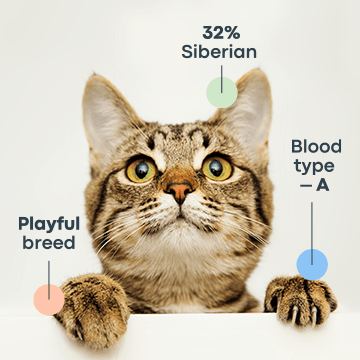
In cat terms, luckily, a chimera cat is not scary at all! Chimeras, as we here know them at Basepaws, are gorgeous and breathtaking genetic anomalies. They are composed of parent cells with different genotypes which most commonly occurs by the merger of multiple fertilized eggs. Due to the presence of two distinct genotypes, both expressing themselves in the phenotype, chimera cat is characterized with a mixture of tissues derived from different genomes. Isn’t that wild?!
What is chimerism, really?
In animals, chimeras are formed from at least four parent cells. They can occur after either two fertilized eggs or two early embryos fuse together into one organism. Thus, an animal chimera will carry two or more genetically distinct populations of cells, originating from different zygotes. Each population of cells keeps its own genotype and its own characters. This results in the formation of a mixture of tissues. During organism development, there is a chance that entire organs will possess different genotypes. For example, the animal can end up with one organ solely composed of one population of cells, and another organ completely built from the other population of cells.
Chimeras are made up of cells from at least two different original embryos. If the early embryos fuse together, they become a single organism whose genetic input comes from two completely different individuals. If two or more genetically distinct cell populations emerge in the same zygote, then this condition is called a mosaic and not a chimera. This is because all the cells originate from the same original organism that genetically diverged due to genetic mutations. They don’t come from two different individuals.
Chimeras can be created artificially too
Chimeras are often artificially produced in biological research. This is conducted by selective transplantation of embryonic cells from one organism onto the embryo of another. However, this should not be confused with hybrids and hybridomas! Hybrids are formed by the fusion of two gametes (i.e. egg and sperm)deriving from two different species into one single zygote. Hybridomas are created by the merger of two cells of different species into one cell. What is the core difference exactly, then? Well, while hybrids and hybridomas have cells deriving from both parent species, chimeras will have cells deriving from only either of the parent species.
How common are chimera cats?
While chimerism among animals is exceedingly rare, among cats, "chimeras are really not all that rare", explained Leslie Lyons, a professor at the University of California, Davis. In fact, Lyons explains that most male tortoiseshell cats are probably chimeras. The tortoiseshell coat in male cats indicates the presence of an extra X chromosome – which is why this coat color is so rare among boys in the first place.

Female tortoiseshell cats have two X chromosomes to begin with, so they don’t necessarily have to be a chimera to sport this coat coloration. Males, however, who normally carry one copy of the X chromosome, have to have an extra copy in order to be tortoiseshell, and therefore are much more likely to be chimeric.
Chimeric feline celebrities
Meet Venus, the greatest cat celebrity out there! She is lovely! And how did she earn this title? Because she takes the chimera mystery to a whole new level! Her perfectly split face and two differently colored eyes divided the internet in two teams. Does she really carry different DNA on each side of her face, or are we looking at a typical example of mosaic? Her coat and eyes can be easily explained with both scenarios.

Venus, a possible Chimera cat
Yes, it is possible that this beautiful cat carries two (or more) cell populations, both expressing themselves in her phenotype. However, since she is a female who naturally has two X chromosomes, her coat may be a typical tortoiseshell coat. It is possible that “the black coloration was randomly activated in all the cells on one side of her face, while the orange coloration was activated on the other, and the two patches met at the midline of her body as she developed.” – explained Lyons.
But Venus also has a blue eye. Her heterochromia can be explained with a white-spotting gene, but she only has one white patch on her chest. Is that enough to explain the blue eye? We don’t know. "She is a bit of a mystery." – concluded Lyons. Only a DNA test could resolve this little feline puzzle.
Other felines who took the internet over with their possible chimerism, completely oblivious to their fame, are Quimera and Narnia.

Quimera, a possible Chimera cat (credits)
Quimera is a two-faced little kitty coming from Argentina. Just like Venus, she may be either chimeric or mosaic. Whatever the case, Quimera is taking the internet by storm. She is described by BoredPanda as "...just gorgeous! Her blue eye especially appears like some kind of precious stone, bright and beautiful and an utter contrast to her other eye. The colour split continues down her chest to her front legs, with the sides reversed."

Narnia De La Grace (also featured in the header) (credits)
Narnia De La Grace, a French diva, is a one-year-old with light grey and black fur on his head, separated evenly in a remarkably straight line. His human companion, Stephanie, describes him as "a little bit shy when he is in a new place, but a very soft and friendly cat. He doesn't know he is so special, but I have a very strong link with him, he is my little baby." According to DailyNews, Narnia has become a hit in France with requests for him to appear on television and at cat shows.
Although less common than in cats, chimerism occurs among other pets too. This is Tiger, an intriguing pup whose DNA results confirmed she is a chimera Labrador! "Tiger has personality plus. She is a very happy girl. She doesn’t take herself too seriously. She is more than a bit of a diva and a rascal." – described Tiger’s pup parent.

A Chimera dog Tiger (credits)
Chimeras are bizarre but striking genetic anomalies. While rare among animals, Chimera cats might be more common than we think. Do you think your cat is a Chimera cat? Share with us, we love hearing your stories!
NB: A possible Chimera cat featured in the heading image is Narnia De La Grace (credits).




